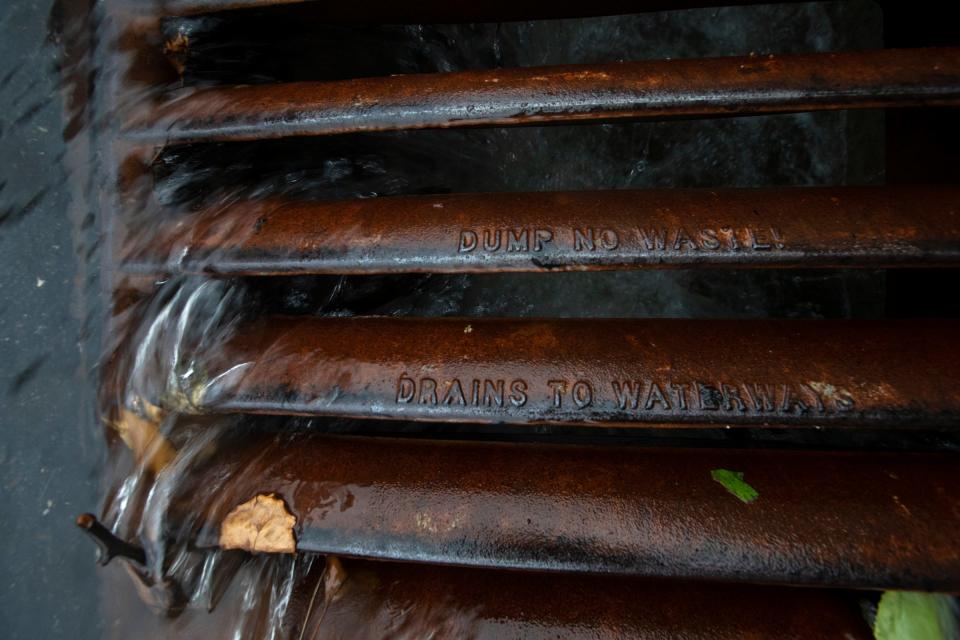Indiana to get $127 million to help clean up lead and other water projects across state
- Oops!Something went wrong.Please try again later.
Indiana has $127 million of federal funds coming its way as part of the recent Bipartisan Infrastructure Law, according to an announcement last week from the U.S. Environmental Protection Agency.
These funds have a specific purpose: water infrastructure projects.
President Joe Biden signed the law on November 15, and it includes $50 billion to the EPA to strengthen the nation’s drinking and wastewater systems. The money is part of $50 billion the EPA was allocated to strengthen the nation's drinking and wastewater systems.
“The law’s investment in water is nothing short of transformational,” EPA Administrator Michael Regan wrote in a letter to Indiana Gov. Eric Holcomb announcing the funding. It is “the single largest investment in water that the federal government has ever made.”
Stormwater: The White River will never be clean unless we tackle the filth hiding in plain sight
The federal agency is allocating nearly $7.4 billion to states, territories and Tribes for 2022. It is the first of five allotments states will receive. Indiana’s $127,705,000 is the 18th most funds that any state is receiving, according to data from the EPA.
Those allotments were determined by formulas outlined in the Clean Water Act as well as an assessment of water infrastructure needs, according to an EPA spokeswoman.

Indiana’s needs are significant. A recent legislative task force on these topics tallied the statewide needs for drinking, waste and stormwater needs to be over $15 billion. That means this funding is less than 1% of Indiana’s infrastructure needs.
Still, Jill Hoffmann with the White River Alliance said that money shouldn’t be discounted.
“If focused, it could be transformative at a regional or local level,” Hoffmann said. “It is important that the new funding be carefully prioritized, or we run the risk of diluting the impact.”
Wastewater: Will DigIndy tunnel be big enough to keep sewage out of the White River?
The majority of the water infrastructure dollars will flow through the State Revolving Funds, and the EPA will evaluate and approve states’ intended use plans for the funding.
It is unclear at the moment how the money will be allocated within Indiana. Gov. Holcomb's office did not respond to IndyStar's requests for comment.
EPA chief Regan has some suggestions on how he would like to see states use the money: They should prioritize underserved communities, he said, including those in rural and urban communities.
“These communities have never received their fair share of federal water infrastructure funding,” Regan said. This is a “historic opportunity to correct longstanding environmental and economic injustices across America.”

Indiana Sen. Sue Glick, R-La Grange, agrees this is a “tremendous opportunity” to return taxpayer dollars into communities in areas that desperately need it.
“They can make some advances in not only upgrading their system but removing the dangerous parts of it,” said Glick, who serves several rural communities in northeast Indiana. “We may not see all that the money gets us, because it’s below ground, but it’s something we all use and something that’s not just for this generation but future generations, too.”
Racial justice: White River clean-up started with civil rights probe, but who benefits?
Much of the funding will be available through grants and principal forgiveness loans. The EPA said it will provide technical assistance to help disadvantaged communities overcome barriers in applying for and receiving loans and grants through the SRFs.
As Glick mentioned, the agency also would like to see these funds go toward not just modernizing water systems, but removing the dangers within them such as lead pipes and exposure to contaminants such as PFAS.
President Biden set an ambitious goal to replace 100% of the nation’s lead service lines, and is asking communities to accelerate their inventories to identify the harmful lines. The EPA also recently announced a PFAS strategic roadmap to lay out a whole-agency approach to address the dangerous forever chemicals.
Focusing on such threats is a “prudent first priority,” Hoffmann said, especially because vulnerable communities are “routinely and disproportionately impacted by environmental contamination.”
“We are certainly not short on threats that need to be mitigated,” she added. “We cannot afford to allow any part of our community to crumble under increased flooding pressures and public health failures.”
The EPA said it will work with states to identify tools and resources to best support states in achieving the goals of the funding.
Call IndyStar reporter Sarah Bowman at 317-444-6129 or email at sarah.bowman@indystar.com. Follow her on Twitter and Facebook: @IndyStarSarah. Connect with IndyStar’s environmental reporters: Join The Scrub on Facebook.
IndyStar's environmental reporting project is made possible through the generous support of the nonprofit Nina Mason Pulliam Charitable Trust.
This article originally appeared on Indianapolis Star: Indiana to get $127M for lead, PFAS and other water projects

